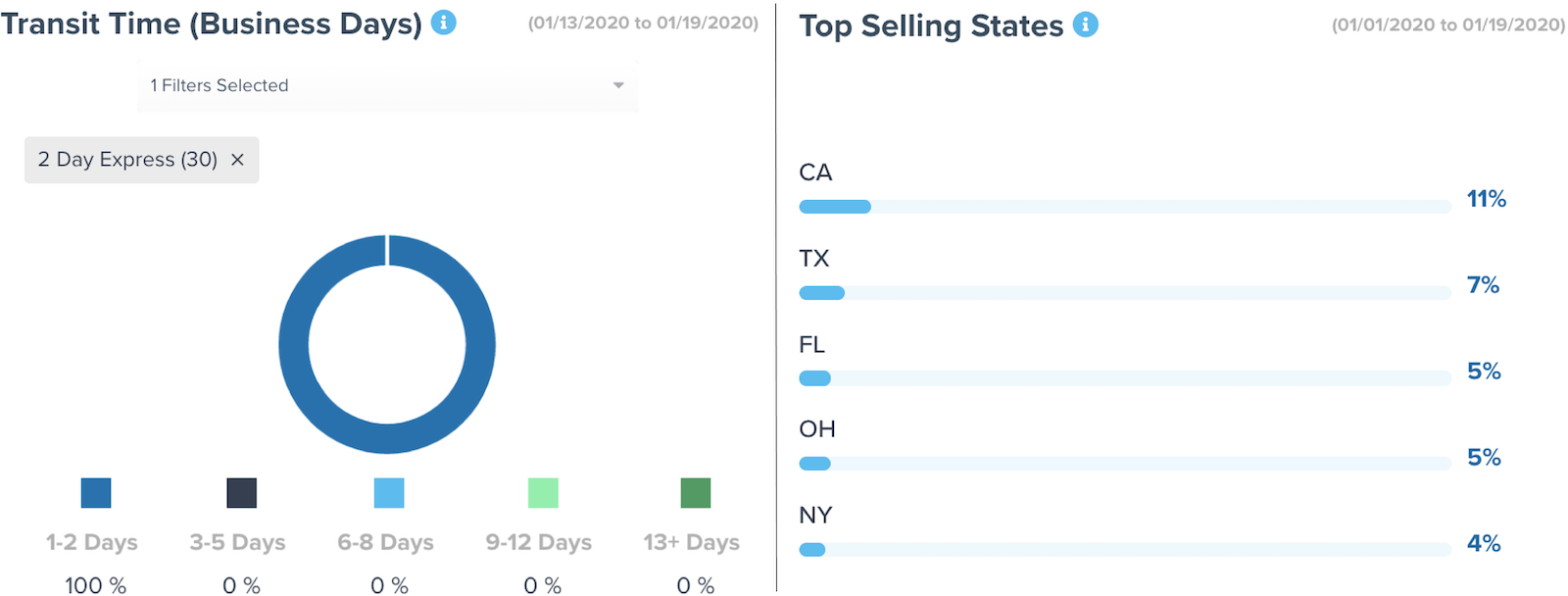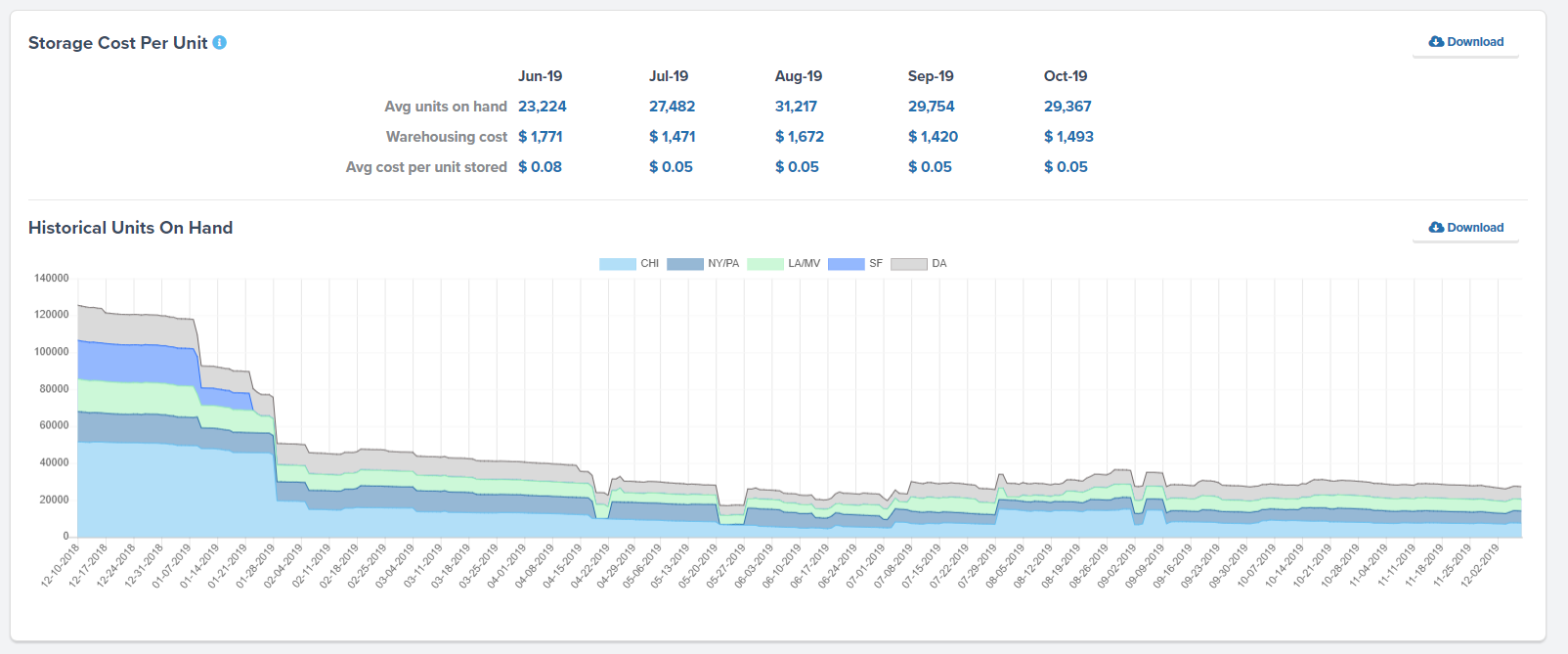Table of Contents
** Minutes
In the ecommerce world today, consumer expectations are always shifting, competition is rising, forecasting is challenging, and customer acquisition costs are more expensive than ever before. At the same time, you need to keep logistics costs down, offer speedy deliveries, and stay ahead of demand.
Here at ShipBob, we believe data can be a competitive advantage for direct-to-consumer brands. That’s why we recently launched a free analytics tool packed with new charts and deeper insights to help you with everything from year-end reporting, to better supply chain optimisation and decision-making.
As a leading fulfilment provider, we’ve aggregated many data sets to provide the information you need at a glance, the ability to download files to get more granular, and empower you to ultimately provide a better customer experience.
“I used to have to pull inventory numbers from three places everyday and move all the disparate data into a spreadsheet. ShipBob has an analytics tab in their dashboard with all of this information, which is great for end-of-month reconciliations.”
Wes Brown, Head of Operations at Black Claw LLC
Here’s a glimpse of some trends and insights you’ll uncover from all orders and inventory processed through ShipBob using our easy-to-understand distribution metrics.
Fulfilment performance
When you outsource fulfilment, you need to keep a close eye on how your 3PL partner is performing. In an effort to provide you with more visibility and to hold ourselves accountable, ShipBob is very transparent with our actual performance compared to our SLA commitments. We provide many operational KPIs to give you an overview of the numbers you care about most.
Get answers to questions like:
- How many of my orders are fulfilled on time (and what’s the breakdown of orders placed, processed, and shipped)?
- How many and which orders can’t be fulfilled because of inadequate stock levels?
- How many days does it take for my orders to be delivered?
- How many times has ShipBob missed its SLAs and which orders were impacted?
“ShipBob provides us with specific reporting that helps us make decisions that directly benefit the health of our business. It shows their dedication to transparency — things like actual transit times and whether they’re hitting their service-level agreements. They are really committed to their customers and keeping themselves accountable.”
Pablo Gabatto, Business Operations Manager at Ample Foods
Shipping insights
ShipBob understands that analytics for your marketing campaigns need to shed light on the entire process, from customers landing on your website to them receiving their orders. Which is why we aim to fulfil orders fast and cost-effectively at speeds your customers want. We aggregate transit times, cart values, shipping methods, and shipping destinations to help you optimise your costs and test different shipping price strategies.
Get answers to questions like:
- Which shipping methods do my customers choose most often?
- How much are my customers spending by shipping method?
- What is my average shipping cost per shipping method?
- How long does it take my orders to be delivered by shipping method?
- Which orders haven’t been delivered yet?
- Which states do I ship the most orders to?

“ShipBob’s analytics dashboard has a lot of valuable reports that show our top-selling states, order revenue and costs, units sold, sales by SKU, days of inventory, SKU velocity, sales vs. inventory distributions showing where our customers are and where we’re shipping from, and more.”
Andrew Hardy, COO of Nature’s Ultra
Demand forecasting
One of the most challenging parts of running an ecommerce business is determining how much inventory to order and keep on hand — without running out of stock or spending too much money on warehousing. ShipBob provides the tools to understand SKU velocity, the impact of promotions on stock levels, how to prioritize the inventory replenishment of certain items, and much more.
“ShipBob is very forward-thinking and leaps and bounds ahead of reporting in other systems. For inventory planning, I love the SKU velocity report, daily average products sold, and knowing how much inventory we have left and how long it will last.”
Wes Brown, Head of Operations at Black Claw LLC
To connect your upstream manufacturing activities with your downstream sales, use the Analytics tool to get answers to questions like:
- How much inventory do I currently have on hand at each ShipBob fulfilment centre?
- What were my historical stock levels at any point in time in any location?
- How many days do I have left until a SKU will be out of stock?
- By when do I need to reorder inventory for each product?
- How often is each product sold across channels?
- If I run a flash sale on my site, how will this affect my available inventory levels?
- How does product demand compare to previous periods?
- How are my sales affected by different seasons and months?
- What are my best-selling items?
- Which items are not generating sales and incurring high ecommerce warehousing fees?
“ShipBob’s analytics tool is really cool. It helps us a lot with planning inventory reorders, seeing when SKUs are going to run out, and we can even set up email notifications so that we’re alerted when a SKU has less than a certain quantity left. There is a lot of value in their technology.”
Oded Harth, CEO & Co-Founder of MDacne
Logistics costs
ShipBob strives to make billing as clear as possible. We provide a detailed line item of every fee that has been billed to your account as well as additional views of your overall fulfilment spend. Understanding your profitability by order, how much you are spending on shipping, and the average amount that customers spend on your store helps you make better decisions, boosting your success in the long run.
“Overall, there is more transparency with ShipBob that even helps our team manage customer service better. I can see the granular stage the order is in — if it’s being picked, packed, in transit, etc. That enhanced visibility is great. No other 3PLs offer that in my experience. Tracking our costs and how much we’re spending on storage is a lot easier to understand.”
Wes Brown, Head of Operations at Black Claw LLC
Get insights into how much you’re spending on logistics with answers to questions like:
- What is my average storage cost per unit?
- What is my average fulfilment cost per order?
- What is the total number of bins/shelves/pallets I’m being charged for?
- What is the average cart value and shipping cost by shipping method and order?
- How much money would I save on shipping if I changed the fulfilment centre locations my inventory is in?

“Storing inventory in different regions is key to reducing costs and transit times. From expanding into a second ShipBob fulfilment centre, we are able to offer 65% of our customers with 2-day shipping, up from 32% by only having a single West Coast facility. Soon, this will be 100%. Not only is this better for our customers, but we also gain a 13% savings to our bottom line.”
Pablo Gabatto, Business Operations Manager at Ample Foods
Inventory allocation and distribution map
ShipBob takes a data-driven approach to helping you decide where you should store your inventory. Based on your past orders, we provide an analysis of which fulfilment centres you should stock to best leverage ShipBob’s network of fulfilment centres. You can easily visualise where your customers are and compare your current and ideal distribution to optimise product allocation.
Get answers to the following questions:
- How should I distribute my inventory across ShipBob’s fulfilment network?
- What would my shipping costs be if I went from one fulfilment centre to two (or two to three, and so on)?
- How many days of inventory do I have left before I run out?
- What is my SKU performance over time?
- Where are my customers shipping to most often?

“We now save a lot of money and ship faster based on distributed inventory. So far, we are shipping out of two of ShipBob’s fulfilment centres. We use the locations that optimise and reduce the distance travelled to get our products into our customers’ hands faster.”
Lindsay Louise, Fulfilment & Retail Manager at Synchro
Learn more
To make the right decisions, you need the best data. ShipBob provides you with actionable insights to drive growth, save money, and understand your business — even when fulfilment is done outside of your four walls.
With our robust fulfilment network, algorithms, and experience partnering with thousands of merchants, we’re happy to offer this next level of transparency to help drive performance improvements.
“We strive to be very data-driven, and ShipBob gives us access to different views of our business. Their analytics tool has been great to have. We can see inventory reconciliations and easily view SKU velocity, transit times, and inventory distribution recommendations.”
Pablo Gabatto, Business Operations Manager at Ample Foods
Get in touch with ShipBob to learn how our fulfilment services and technology can help your ecommerce business.









